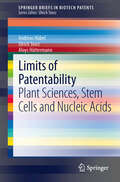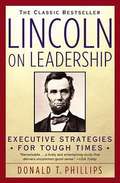- Table View
- List View
Limitless Mind: Learn, Lead, and Live Without Barriers
by Jo BoalerIn this revolutionary book, a professor of education at Stanford University and acclaimed math educator who has spent decades studying the impact of beliefs and bias on education, reveals the six keys to unlocking learning potential, based on the latest scientific findings.From the moment we enter school as children, we are made to feel as if our brains are fixed entities, capable of learning certain things and not others, influenced exclusively by genetics. This notion follows us into adulthood, where we tend to simply accept these established beliefs about our skillsets (i.e. that we don’t have “a math brain” or that we aren’t “the creative type”). These damaging—and as new science has revealed, false—assumptions have influenced all of us at some time, affecting our confidence and willingness to try new things and limiting our choices, and, ultimately, our futures. Stanford University professor, bestselling author, and acclaimed educator Jo Boaler has spent decades studying the impact of beliefs and bias on education. In Limitless Mind, she explodes these myths and reveals the six keys to unlocking our boundless learning potential. Her research proves that those who achieve at the highest levels do not do so because of a genetic inclination toward any one skill but because of the keys that she reveals in the book. Our brains are not “fixed,” but entirely capable of change, growth, adaptability, and rewiring. Want to be fluent in mathematics? Learn a foreign language? Play the guitar? Write a book? The truth is not only that anyone at any age can learn anything, but the act of learning itself fundamentally changes who we are, and as Boaler argues so elegantly in the pages of this book, what we go on to achieve.
Limitless: Leadership that Endures
by Ajaz AhmedThere isn’t a magic formula for better leadership. But there is an enduring philosophy behind the most inspiring leaders in business, past and present. It’s one that has outlasted markets, currencies, meltdowns, revolutions and regime changes. Limitless is a celebration of the transformative power of thinking beyond conventional boundaries. Its fascinating true stories of the most audacious and accomplished business leaders remind us how the entrepreneurial spirit really does change the world for the better. The greatest leaders not only make a difference in their own times, but also leave behind the lessons they’ve learned for the world that goes on after them. Finding opportunities where others see obstacles, they show that the greatest investment any entrepreneur can make is to keep an open mind.
Limitless: The Federal Reserve Takes on a New Age of Crisis
by Jeanna SmialekThis fascinating deep dive into one of the most powerful and least understood American institutions—the Federal Reserve—is &“a riveting narrative...[and] an invaluable guide to the monetary policy debates of the last few years" (Liaquat Ahamed, Pulitzer Prize-winning author of Lords of Finance).&“The best book on the Fed in our time and a model of financial writing.&” –KirkusThe marble halls of the Federal Reserve have always held secrets; for decades the Fed did the utmost to preserve its room to maneuver, operating behind the scenes as much as possible. Yet over the past two decades, this elite world of bankers and economists speaking a language that only monetary experts could understand has been forced to change its ways. Amid rising inequality, weakening global economic prospects, and a pandemic, the central bank has entered into a new era of transparency and activism that has changed its role in modern society in subtle but remarkable ways.Limitless tells the inside story of this deeply impactful transformation, and what it means for ordinary Americans. Focusing on characters such as the Fed chairman Jerome Powell; the Vice Chair for Supervision Randal Quarles; Vice Chair Lael Brainard; the Minneapolis Fed president Neel Kashkari; and the long-ago Fed Chair Marriner S. Eccles—and driven by the rising tension between Main Street and Wall Street—this is a page-turning account of the modern Fed&’s inner workings during a crucial inflection point in history.
Limits of Economic and Social Knowledge
by Stephen J. DecanioThe book aims to show that the deterministic vision embodied in conventional economic modelling is neither consistent with nor supported by the state of the art in mathematics, logic, and physical science. DeCanio recognizes that economic agents are intrinsically free and somewhat unpredictable, which is essential for economic and social theory.
Limits of Patentability
by Ulrich Storz Andreas Hübel Aloys HüttermannSpringerBriefs in Biotech Patents presents timely reports on intellectual properties (IP) issues and patent aspects in the field of biotechnology. In this volume the limits of patentability are addressed, a question that is often raised when it comes to biotechnological inventions: The first section addresses current issues in the patentability of plants produced by essentially biological processes including the controversy between farmer's privilege and patent exhaustion with respect to seeds in the US. The second section examines the patentability of human embryonic stem cells in Europe and the US, also considering alternative technologies with respect to their practicability and patentability. The third section focuses on the patentability of genes and nucleic acids, especially the issue of patenting of encoding genes and nucleic acids.
Limits of a Post-Soviet State: How Informality Replaces, Renegotiates, and Reshapes Governance in Contemporary Ukraine (Soviet and Post-Soviet Politics and Society #154)
by Abel PoleseThough informed by case studies conducted in Ukraine, this book transcends its country-specific scope. It explains why informality in governance is not necessarily transitory or temporary but a constant in most political systems. The book discusses self-protective mechanisms, responses to incomplete or unfocused policy making, and strategies employed by individuals, classes, and communities to respond to unusual demands. The book argues that when state or company expectations exceed normative behavior, informal behavior continues to thrive. New tactics help cope with the reality of governance. Informality also challenges the values imposed by power through attitudes and behaviors that take place "beyond" or "in spite of" the state.
Limits to Privatization: How to Avoid Too Much of a Good Thing - A Report to the Club of Rome
by Oran R. Young Matthias Finger Marianne Beisheim Ernst Ulrich von Weizs&Limits to Privatization is the first thorough audit of privatizations from around the world. It outlines the historical emergence of globalization and liberalization, and from analyses of over 50 case studies of best- and worst-case experiences of privatization, it provides guidance for policy and action that will restore and maintain the right balance between the powers and responsibilities of the state, the private sector and the increasingly important role of civil society. The result is a book of major importance that challenges one of the orthodoxies of our day and provides a benchmark for future debate.
Limits to Regional Integration (The International Political Economy of New Regionalisms Series)
by Søren DosenrodeRegionalization in general and regional integration in particular have taken place at a growing pace since the end of the Cold War, when states were set free from various security overlays. Regional integration is ’logical’ as it is supposed to advance wealth and peace. Still, the picture is far from clear and the process of regional integration is not automatic; disintegration takes place, as we saw in the cases of the Soviet Union, Yugoslavia and Czechoslovakia to mention a few. This is the case not only in states recently brought together but also in traditional states like Britain, The Netherlands and Spain where strong groups strive for independence. In some places regionalization is flourishing, but regional integration is not. Some regional integration projects like the North American Free Trade Agreement and Mercosur seem to stagnate. Certainly there are limits to regional integration. This comprehensive volume, written by high profiled academics, covers these themes by examining eleven cases ranging from the lack of integration in the Arctic and the Middle East, to ongoing or progressing integration in Europe to uncover what ’blocks’ regional integration, the results of which are used for developing new theoretical insights.
Limits to Terrestrial Extraction (Routledge Focus on Energy Studies)
by Robert E. KirschThis volume focuses on the social, cultural, and ecological consequences of a political economy of energy. A political economy of energy holds that an enduring hallmark of the current context is a reorganization of human society toward energy extraction and production. Limits to Terrestrial Extraction looks at the construction of society itself as an energy-harvesting “megamachine,” the ecomodernist project of the latter half of the twentieth century and its disastrous environmental record, and mining Near Earth Objects to extract extraterrestrial resources. Each chapter explores a limit to terrestrial extraction – spatially, economically, or socially – finding that business as usual cannot yield a different world. The authors eschew easy answers of natural resource management or discourses of wise use, instead offering critiques of market society and its constitutive drive to produce and waste energy. Overall, this volume establishes the existential stakes and scope of change that will be required to build a better world. This book will be of great interest to students and scholars of environmental political theory, as well as social scientists and humanities scholars who study the intersection of energy and society.
Limits: Why Malthus Was Wrong and Why Environmentalists Should Care (Stanford Briefs)
by Giorgos KallisWestern culture is infatuated with the dream of going beyond, even as it is increasingly haunted by the specter of apocalypse: drought, famine, nuclear winter. How did we come to think of the planet and its limits as we do? This book reclaims, redefines, and makes an impassioned plea for limits—a notion central to environmentalism—clearing them from their association with Malthusianism and the ideology and politics that go along with it. Giorgos Kallis rereads reverend-economist Thomas Robert Malthus and his legacy, separating limits and scarcity, two notions that have long been conflated in both environmental and economic thought. Limits are not something out there, a property of nature to be deciphered by scientists, but a choice that confronts us, one that, paradoxically, is part and parcel of the pursuit of freedom. Taking us from ancient Greece to Malthus, from hunter-gatherers to the Romantics, from anarchist feminists to 1970s radical environmentalists, Limits shows us how an institutionalized culture of sharing can make possible the collective self-limitation we so urgently need.
Lin's Uncommon Life
by Scott Shackelford Emily CastleElinor (Lin) Ostrom's life was an incredible journey. Being the first woman ever to win a Nobel Prize in Economics was an achievement of a lifetime. But it was just the culmination of a life spent struggling against the odds.Even while overcoming childhood hardships and a stutter and being denied opportunities because she was a woman, Lin never lost sight of the wonders around her and was always curious to learn more. Lin would teach generations of students the lessons she learned through a lifetime of research and dedication. As Lin said "little by little, bit by bit, family by family, so much good can be done on so many levels."Discover Lin's Uncommon Life, and let it be an inspiration to follow your own path. Small steps, taken one at a time, can lead you somewhere truly uncommon in the end.
Linchpin: Are You Indispensable?
by Seth GodinThis life-changing manifesto shows how you have the potential to make a huge difference wherever you are. Few authors have had the kind of lasting impact and global reach that Seth Godin has had. In a series of now-classic books that have been translated into 36 languages and reached millions of readers around the world, he has taught generations of readers how to make remarkable products and spread powerful ideas. In Linchpin, he turns his attention to the individual, and explains how anyone can make a significant impact within their organization. There used to be two teams in every workplace: management and labor. Now there's a third team, the linchpins. These people figure out what to do when there's no rule book. They delight and challenge their customers and peers. They love their work, pour their best selves into it, and turn each day into a kind of art. Have you ever found a shortcut that others missed? Seen a new way to resolve a conflict? Made a connection with someone others couldn't reach? Even once? Then you have what it takes to become indispensable, by overcoming the resistance that holds people back. Linchpin will show you how to join the likes of... · Keith Johnson, who scours flea markets across the country to fill Anthropologie stores with unique pieces. · Jason Zimdars, a graphic designer who got his dream job at 37signals without a résumé. · David, who works at Dean and Deluca coffee shop in New York. He sees every customer interaction as a chance to give a gift and is cherished in return. As Godin writes, "Every day I meet people who have so much to give but have been bullied enough or frightened enough to hold it back. It's time to stop complying with the system and draw your own map. You have brilliance in you, your contribution is essential, and the art you create is precious. Only you can do it, and you must."
Linchpin: Are You Indispensable? How to drive your career and create a remarkable future
by Seth GodinIn this 'compelling, accessible and purpose-filled book,' (Alan Webber, Founder, Fast Company) bestselling business author Seth Godin shows how you have the potential to make a big difference-and make yourself indispensable in the process-wherever you are.Why are some people easily outsourced, downsized, or freelanced into obscurity, while others have their pick of opportunities? In his most powerful book yet, Seth Godin argues that it's more essential than ever to become indispensable - to become a linchpin. Linchpins are the essential building blocks of great organizations: they invent, lead (regardless of title), connect others, make things happen, and create order out of chaos. They love their work and pour their best selves into it and turn each day into a kind of art - and, in today's world, they get the best jobs and the most freedom.Godin shows that the key to being indispensable is overcoming the fears that hold most of us back. If you have you ever found a shortcut that others missed, seen a new way to resolve a conflict, or made a connection with someone others couldn't reach, then you have what it takes to become indispensable. It's time to stop complying with the system and draw your own map.'Thousands of authors write business books every year, but only a handful reach star status and the A-list lecture circuit. Fewer still - one, to be exact - can boast his own action figure. . .Godin delivers his combination of counterintuitive thinking and a great sense of fun' BusinessWeek
Lincoln Electric
by Jordan SiegelThe case describes Lincoln Electric's business strategy and incentive system, and it discusses the global strategy choices that the company faces going forward. Lincoln Electric is deciding whether a strong push into India should be the next step in the company's globalization. The company has enjoyed increasing success in China as a result of its aggressive expansion through both a joint venture and set of majority-owned plants. The company is deciding how it could apply the lessons of the Chinese experience, as well as the lessons of its experience across Asia, Europe, and Latin America, to India. First of all, should Lincoln Electric own a manufacturing operation in India? If yes, Lincoln Electric could enter the India market by acquisition, by joint venture, or by building a new plant on its own. If the company were to enter by acquisition, it was unclear what type of valuation to apply to any of the Indian incumbent companies. If the company were to enter by joint venture, the question was: How could Lincoln ensure its ability to make key business decisions? If the company were to build its own plant, the question was: Would the cost of starting from scratch be more than sufficiently compensated by the total control the company would enjoy?
Lincoln Electric Co.
by Norman A. Berg Norman D. FastCovers the strategy and management practices of the world's largest manufacturer of welding equipment. Discusses the compensation system and company culture, and the leadership style of management.
Lincoln Electric's Harsh Lessons from International Expansion
by Donald F. HastingsLess than half an hour after Donald Hastings became chairman and CEO of the Lincoln Electric Company in July 1992, he got the shocking news: losses from the company's European operations were so steep that Lincoln was at risk of defaulting on its loans and being unable to pay its employees their year-end bonus. Since the bonus was the foundation of the company's unusually successful manufacturing operations, Hastings knew that failure to pay it could lead to the company's unraveling. How had Lincoln gotten into this predicament? By a program of rapid foreign expansion. Lincoln was primarily a U.S. company until the mid-1980s, but recession at home and competition from abroad led executives to dream that the company could become a global power. Between 1986 and 1991, Lincoln took on unprecedented debt in order to finance foreign acquisitions, mostly in Europe. A number of factors doomed the venture: recession in Europe, unfamiliarity with Europe's labor culture, lack of international expertise at the top. But the root cause, Hastings admits, was overconfidence on the part of Lincoln's leaders in the company's manufacturing abilities and systems. Hastings, now chairman emeritus, recounts how the company suffered through the early 1990s and then returned to prosperity. It wrote off most of its European operations, ramped up domestic production and sales, and hired top managers and board members with international experience. As a result of strenuous efforts at all levels of the company, it managed to keep paying the bonus and to largely regain the trust of its people.
Lincoln Electric: Venturing Abroad
by Christopher A. Bartlett Jamie O'ConnellLincoln Electric, a 100-year-old manufacturer of welding equipment and consumables based in Cleveland, Ohio, motivates its U.S. employees through a culture of cooperation between management and labor and an unusual compensation system based on piecework and a large bonus based on individual contribution to the company's performance. Despite opening a few international sales and production ventures in Canada, Australia, and France, Lincoln remained focused on manufacturing in the United States until 1988. At that time, the company's new CEO expanded manufacturing through acquisitions and greenfields in 11 new countries, attempting to transfer its unique management philosophy to each. However, Lincoln was unable to replicate its highly productive system abroad. Operational problems led to a major restructuring in the early 1990s, supervised by Anthony Massaro, a newcomer to the company. In 1996, Massaro was named CEO and set about expanding the company's manufacturing base through a new strategy. The case concludes in Asia, where Lincoln's regional president is trying to decide whether and how to establish a manufacturing presence in Indonesia, and in particular whether to try to transfer Lincoln's unique incentive-driven management system.
Lincoln Financial Group (A)
by David Lane David B. GodesLFG reorganizes its business in order to improve customer intimacy. However, to implement the strategy, they need to effect significant changes in the skills of their salespeople. This case series straddles human resource management, corporate strategy, and sales management by exploring the link between a shift in the firm's overall strategy (customer intimacy), the structural implementation of this strategy in the form of the creation of a new distribution company and, finally, the transformation of the selling approach through skills assessment and development. The (A) case describes the firm's strategic position as the "manufacturer" of three primary product lines--annulities, insurance, and mutual funds--which they sell to banks, broker/dealers, and independent planners. Most of their customers have just one of these products 'on the shelf.' In 2000, they create Lincoln Financial Distributors (LFD) which will be responsible for the wholesaling of all of these products. The case ends by asking the students to (a) react to this idea and (b) formulate a plan for its implementation. Simply taking salespeople away from their product group and housing them side-by-side with other salespeople selling other products is unlikely to create true customer intimacy. Wes Thompson, LFD's President and Kim Miner, the Human Resources VP, undertake a sweeping effort in which they create a "competency model," denoting precisely what they want their salespeople to be good at, assessing the sales force on these dimensions, and then hiring or training in order to get where they want to be. The (B) case provides rich detail of the model, the assessment approach and the results of the assessments. As the (C) case lays out, the results are stunning in terms of their relationships as well as from a financial perspective. The (C) then ends by offering a strategy for "Act II'" significantly expanding the number of salespeople at LFD.
Lincoln Financial Group (B): Making LFD a Reality
by David Lane David B. GodesLFG reorganizes its business in order to improve customer intimacy. However, to implement the strategy, they need to effect significant changes in the skills of their salespeople. This case series straddles human resource management, corporate strategy, and sales management by exploring the link between a shift in the firm's overall strategy (customer intimacy), the structural implementation of this strategy in the form of the creation of a new distribution company and, finally, the transformation of the selling approach through skills assessment and development. The (A) case describes the firm's strategic position as the "manufacturer" of three primary product lines--annuities, insurance, and mutual funds--which they sell to banks, broker/dealers, and independent planners. Most of their customers have just one of these products 'on the shelf.' In 2000, they create Lincoln Financial Distributors (LFD) which will be responsible for the wholesaling of all of these products. The case ends by asking the students to (a) react to this idea and (b) formulate a plan for its implementation. Simply taking salespeople away from their product group and housing them side-by-side with other salespeople selling other products is unlikely to create true customer intimacy. Wes Thompson, LFD's President and Kim Miner, the Human Resources VP, undertake a sweeping effort in which they create a "competency model," denoting precisely what they want their salespeople to be good at, assessing the sales force on these dimensions, and then hiring or training in order to get where they want to be. The (B) case provides rich detail of the model, the assessment approach and the results of the assessments. As the (C) case lays out, the results are stunning in terms of their relationships as well as from a financial perspective. The (C) then ends by offering a strategy for "Act II'" significantly expanding the number of salespeople at LFD.
Lincoln Financial Group (C)
by David Lane David B. GodesLFG reorganizes its business in order to improve customer intimacy. However, to implement the strategy, they need to effect significant changes in the skills of their salespeople. This case series straddles human resource management, corporate strategy, and sales management by exploring the link between a shift in the firm's overall strategy (customer intimacy), the structural implementation of this strategy in the form of the creation of a new distribution company and, finally, the transformation of the selling approach through skills assessment and development. The (A) case describes the firm's strategic position as the "manufacturer" of three primary product lines--annuities, insurance, and mutual funds--which they sell to banks, broker/dealers, and independent planners. Most of their customers have just one of these products 'on the shelf.' In 2000, they create Lincoln Financial Distributors (LFD) which will be responsible for the wholesaling of all of these products. The case ends by asking the students to (a) react to this idea and (b) formulate a plan for its implementation. Simply taking salespeople away from their product group and housing them side-by-side with other salespeople selling other products is unlikely to create true customer intimacy. Wes Thompson, LFD's President and Kim Miner, the Human Resources VP, undertake a sweeping effort in which they create a "competency model," denoting precisely what they want their salespeople to be good at, assessing the sales force on these dimensions, and then hiring or training in order to get where they want to be. The (B) case provides rich detail of the model, the assessment approach and the results of the assessments. As the (C) case lays out, the results are stunning in terms of their relationships as well as from a financial perspective. The (C) then ends by offering a strategy for "Act II'" significantly expanding the number of salespeople at LFD.
Lincoln on Leadership for Today: Abraham Lincoln's Approach to 21st-Century Issues
by Donald T. Phillips&“Phillips has a gift for making 19th-century history relevant for the 21st century . . . a marvelous way to think about our current policy woes.&” —Douglas Brinkley, New York Times-bestselling author of American Moonshot How can President Lincoln&’s wisdom be applied to the most pressing conflicts of modern-day America? With a fresh and perceptive reading of Lincoln&’s own writings and speeches, bestselling author Donald T. Phillips reveals how America&’s sixteenth president handled many of the same national dilemmas we face today. Looking to his exemplary leadership of a fractured nation, Phillips offers a deeply relevant analysis of how Lincoln&’s example could help forge solutions to the many issues and divisions challenging our country now. &“[An] intelligent and often moving look at one of the nation&’s greatest presidents . . . Using his extensive knowledge of Lincoln, Phillips makes convincing cases throughout for what the nineteenth-century statesman&’s opinion would be on a wide array of issues faced by the twenty-first-century United States, including climate change, torture, immigration, and equal pay for women. For readers who find present-day politics almost too much to contemplate, Phillips&’s closing vision of Lincoln witnessing the &‘current state of affairs&’ will be especially poignant and bittersweet.&” —Publishers Weekly
Lincoln on Leadership: Executive Strategies for Tough Times
by Donald T. PhillipsLincoln on Leadership is the first book to examine Abraham Lincoln's diverse leadership abilities and how they can be applied to today's complex world.
Lincolnomics: How President Lincoln Constructed the Great American Economy
by John F. WasikA biography of Abraham Lincoln that examines his untold legacy as the Great Builder of American infrastructure. Abraham Lincoln&’s view of the right to fulfill one&’s economic destiny was at the core of his governing philosophy―but he knew no one could climb that ladder without strong federal support. Some of his most enduring policies came to him before the Civil War, visions of a country linked by railroads running ocean to ocean, canals turning small towns into bustling cities, public works bridging farmers to market. Expertly appraising the foundational ideas and policies on infrastructure that America&’s sixteenth president rooted in society, John F. Wasik tracks Lincoln from his time in the 1830s as a young Illinois state legislator pushing internal improvements; through his work as a lawyer representing the Illinois Central Railroad in the 1840s; to his presidential fight for the Transcontinental Railroad; and his support of land-grant colleges that educated a nation. To Lincoln, infrastructure meant more than the roads, bridges, and canals he shepherded as a lawyer and a public servant. These brick-and-mortar developments were essential to a nation&’s lifting citizens above poverty and its isolating origins. Lincolnomics revives the disremembered history of how Lincoln paved the way for Eisenhower&’s interstate highways and FDR&’s social amenities. With an afterword addressing the failure of American infrastructure during the COVID-19 pandemic, and how Lincoln&’s policies provide a guide to the future, Lincolnomics makes the case for the man nicknamed &“The Rail Splitter&” as the Presidency&’s greatest builder. &“In this unique blend of biography and policy prescription, journalist Wasik . . . casts Abraham Lincoln as America&’s &“foremost moral architect of economic and social opportunity&” and looks to his life and political career for lessons in how the nation might rebuild its infrastructure and redress income inequality. . . . Wasik convincingly argues that [Lincoln&’s] economic policies deserve more credit.&” —Publishers Weekly &“While revealing as history, Wasik&’s account about the first Republican President&’s launches of infrastructure shame the ignorant, obstinate, narcissist Republicans of today who wish instead to build up tyrant Trump&’s political infrastructure. This is a book to be read and used today.&” —Ralph Nader &“Wasik invented a new word for this book because his theme bears new force: Abraham Lincoln sought a better-built nation and a freer legal space to help every individual, regardless of background, to aspire and rise. Most historians know this too vaguely about Lincoln; Wasik finally gives the great democratic idea the prominence it deserves.&” —James M. Cornelius, Ph.D., editor, Journal of the Abraham Lincoln Association
Lind Equipment
by Richard S. Ruback Royce YudkoffLind Equipment failed to meet its loan covenants with its senior bank lender in the summer of 2008, just six months after it was acquired. While the senior bank debt comprised only 6% of the capital used in the acquisition and was fully secured, it exercised its right to stop payments to Lind's subordinated lender that funded about 40% of the acquisition, pushing that debt into default as well. These financial problems were the result of declining revenues and profits at Lind as exchange rates and the impact of the Great Recession took its toll on the firm. Without a quick solution, Lind could be pushed into bankruptcy.
Linda Fay Harris
by Leslie A. Perlow Thomas J. DelongPresents profiles written by six members of the HBS Class of 1976 from the 10th and 20th reunions. The six alumni represent a cross section of the class of 1976 and provide a snapshot of life at the time of the reunions.
















